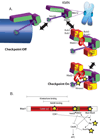Linking kinetochore-microtubule binding to the spindle checkpoint
- PMID: 18410725
- PMCID: PMC2696048
- DOI: 10.1016/j.devcel.2008.03.015
Linking kinetochore-microtubule binding to the spindle checkpoint
Abstract
The spindle checkpoint blocks cell-cycle progression until chromosomes are properly attached to the mitotic spindle. Popular models propose that checkpoint proteins associate with kinetochores to produce a "wait anaphase" signal that inhibits anaphase. Recent data suggest that a two-state switch results from using the same kinetochore proteins to bind microtubules and checkpoint proteins. At least eight protein kinases are implicated in spindle checkpoint signaling, arguing that a traditional signal transduction cascade is integral to spindle checkpoint signaling.
Figures



Similar articles
-
Spindle checkpoint proteins and chromosome-microtubule attachment in budding yeast.J Cell Biol. 2004 Feb 16;164(4):535-46. doi: 10.1083/jcb.200308100. Epub 2004 Feb 9. J Cell Biol. 2004. PMID: 14769859 Free PMC article.
-
Bub1 and aurora B cooperate to maintain BubR1-mediated inhibition of APC/CCdc20.J Cell Sci. 2005 Aug 15;118(Pt 16):3639-52. doi: 10.1242/jcs.02487. Epub 2005 Jul 26. J Cell Sci. 2005. PMID: 16046481
-
BubR1 is essential for kinetochore localization of other spindle checkpoint proteins and its phosphorylation requires Mad1.J Cell Biol. 2002 Aug 5;158(3):487-96. doi: 10.1083/jcb.200204048. Epub 2002 Aug 5. J Cell Biol. 2002. PMID: 12163471 Free PMC article.
-
Attachment and tension in the spindle assembly checkpoint.J Cell Sci. 2002 Sep 15;115(Pt 18):3547-55. doi: 10.1242/jcs.00029. J Cell Sci. 2002. PMID: 12186941 Review.
-
How the SAC gets the axe: Integrating kinetochore microtubule attachments with spindle assembly checkpoint signaling.Bioarchitecture. 2015;5(1-2):1-12. doi: 10.1080/19490992.2015.1090669. Epub 2015 Oct 2. Bioarchitecture. 2015. PMID: 26430805 Free PMC article. Review.
Cited by
-
Spindle assembly checkpoint: the third decade.Philos Trans R Soc Lond B Biol Sci. 2011 Dec 27;366(1584):3595-604. doi: 10.1098/rstb.2011.0072. Philos Trans R Soc Lond B Biol Sci. 2011. PMID: 22084386 Free PMC article. Review.
-
Bub3p facilitates spindle checkpoint silencing in fission yeast.Mol Biol Cell. 2009 Dec;20(24):5096-105. doi: 10.1091/mbc.e09-09-0762. Mol Biol Cell. 2009. PMID: 19846658 Free PMC article.
-
Kinetochore-microtubule interactions: steps towards bi-orientation.EMBO J. 2010 Dec 15;29(24):4070-82. doi: 10.1038/emboj.2010.294. Epub 2010 Nov 23. EMBO J. 2010. PMID: 21102558 Free PMC article. Review.
-
Connecting the microtubule attachment status of each kinetochore to cell cycle arrest through the spindle assembly checkpoint.Chromosoma. 2015 Dec;124(4):463-80. doi: 10.1007/s00412-015-0515-z. Epub 2015 Apr 28. Chromosoma. 2015. PMID: 25917595 Review.
-
Nearly complete deletion of BubR1 causes microcephaly through shortened mitosis and massive cell death.Hum Mol Genet. 2019 Jun 1;28(11):1822-1836. doi: 10.1093/hmg/ddz022. Hum Mol Genet. 2019. PMID: 30668728 Free PMC article.
References
-
- Basto R, Gomes R, Karess RE. Rough deal and Zw10 are required for the metaphase checkpoint in Drosophila. Nature Cell Biology. 2000;2:939–943. - PubMed
-
- Baumann C, Korner R, Hofmann K, Nigg EA. PICH, a centromere-associated SNF2 family ATPase, is regulated by Plk1 and required for the spindle checkpoint. Cell. 2007;128:101–114. - PubMed
-
- Brady DM, Hardwick KG. Complex formation between Mad1p, Bub1p and Bub3p is crucial for spindle checkpoint function. Curr. Biol. 2000;10:675–678. - PubMed
-
- Chan GK, Jablonski SA, Starr DA, Goldberg ML, Yen TJ. Human Zw10 and ROD are mitotic checkpoint proteins that bind to kinetochores. Nat Cell Biol. 2000;2:944–947. - PubMed
Publication types
MeSH terms
Substances
Grants and funding
LinkOut - more resources
Full Text Sources

